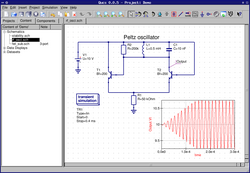क्यू यू सी एस
 Logo QUCS | |
 Screenshot of QUCS | |
| रचनाकार | Michael Margraf, Stefan Jahn et al. |
|---|---|
| पहला संस्करण | 8 दिसम्बर 2003 |
| आखिरी संस्करण | 0.0.18 / 31 अगस्त 2014 |
| प्रोग्रामिंग भाषा | C++ |
| ऑपरेटिंग सिस्टम | Mac OS, Windows, GNU/Linux, Solaris, FreeBSD |
| प्रकार | EDA |
| लाइसेंस | GNU General Public License v2+ |
| वेबसाइट | qucs |
क्यू यू सी एस का पूरा नाम Quite Universal Circuit Simulator है। यह एक मुक्तस्रोत सॉफ्टवेयर है जो एलेक्ट्रानिक परिपथों के विश्लेषण के लिये उपयोगी है। इसकी सहायता से की परिपथ स्कीमैटिक रूप में बनाकर उसका सिमुलेशन किया जा सकता है। इसमें वीएचडीएल या वेरिलॉग का प्रयोग करते हे की डिजिटल परिपथ भी सिमुलेट किया जा सकता है। इसमें अन्य अवयवों के अलावा स्पाइस के टेक्स्ट के रूप में वर्णित सब-सर्किट भी लिये जा सकते हैं। यह पी-स्पाइस आदि परिपथ सिमुलेटरों का एक उत्तम मुक्तस्रोत विकल्प है। कुछ मामलों में यह उससे भी आगे है।
उपलब्ध विश्लेषण (Analysis Types)
- S-parameter, including noise
- AC, including noise
- DC
- Transient Analysis
- Harmonic Balance (not yet finished)
- Digital simulation: VHDL as well as Verilog-HDL
- Parameter sweeps
मुख्य विशेषताएँ (Features at a glance)
- Easy to use graphical interface for schematic capture.
- Simulation data representation in various types of diagrams, i.e., Smith-Chart, Cartesian, Tabular, Polar, Smith-Polar combination, 3D-Cartesian, Locus Curve, Timing Diagram and Truth Table.
- Transmission line calculator.
- Filter synthesis.
- Smith-Chart tool for power and noise matching.
- Attenuator design synthesis.
- Device model and subcircuit library manager.
- Optimizer for analog designs.
- Verilog-A interface.
- Support for multiple languages (GUI and internal help system).
- Subcircuit (including parameters) hierarchy.
- Powerful data post-processing possible using equations.
- Symbolically defined nonlinear and linear devices.
- Documentation including
- many useful tutorials (WorkBook),
- reports (ReportBook),
- technical description of the simulator.
उपलब्ध उपकरण (Tool Suite)
क्यू यू सी एस अनेक प्रोग्रामों का समूह है। ये प्रोग्राम अकेले भी काम कर सकते हैं किन्तु इसमें वे जीयूआई के माध्यम से परस्पर एकीकृत रूप में काम करते हैं। प्रमुख प्रोग्राम हैं -
- स्वयं इसका जीयूआई
- The GUI is used to create schematics, setup simulations, display simulation results, writing VHDL code, etc.
- एनलॉग सिमुलेटर (the backend analogue simulator)
- The analogue simulator is a command line program which is run by the GUI in order to simulate the schematic which you previously setup. It takes a netlist, checks it for errors, performs the required simulation actions and finally produces a dataset.
- एक सरल टेक्स्ट-सम्पादक
- The text editor is used to display netlists and simulation logging informations, also to edit files included by certain components (e.g. SPICE netlists, or Touchstone files).
- फिल्टर संश्लेषण का अनुप्रयोग (a filter synthesis application)
- The program can be used to design various types of filters.
- ट्रान्समिसन लाइन गणक (a transmission line calculator)
- The transmission line calculator can be used to design and analyze different types of transmission lines (e.g. microstrips, coaxial cables).
- अवयवों की लाइब्रेरी (a component library)
- The component library manager holds models for real life devices (e.g. transistors, diodes, bridges, opamps). It can be extended by the user.
- अटीनुएटर संश्लेषण अनुप्रयोग (an attenuator synthesis application)
- The program can be used to design various types of passive attenuators.
- एक कमाण्ड लाइन परिवर्तक प्रोग्राम (a command line conversion program)
- The conversion tool is used by the GUI to import and export datasets, netlists and schematics from and to other CAD/EDA software. The supported file formats as well as usage information can be found on the manpage of qucsconv.
इसके अलावा इसका जीयूआई अन्य उपकरणों को चलाता है। इसमें आंकिक सिमुलेशन के लिये FreeHDL [1] नामक प्रोग्राम का सहारा लिया जाता है और परिपथ इष्टतमीकरण (optimizations) के लिये ASCO [2] का सहायता ली जाती है।
अयवय समूह (Components)
- Lumped components
- Sources
- Probes
- Transmission lines
- Nonlinear components (diodes, transistors, etc.)
- Digital components
- File containers (S-parameter datasets, SPICE netlists)
- Paintings
उपलब्ध ट्रांजिस्टर मॉडल
- FBH-HBT
- HICUM L0 v1.12
- HICUM L0 v1.2
- HICUM L2 v2.1
- HICUM L2 v2.22
- HICUM L2 v2.23
- MESFET (Curtice, Statz, TOM-1 and TOM-2)
- SGP (SPICE Gummel-Poon)
- MOSFET
- JFET
- EPFL-EKV MOSFET v2.6
QUCS के स्किमटिक में समीकरणों (equations) का उपयोग करके स्कीमैटिक और सिमुलेशन को आसान बनाया जा सकता है। समीकरणों में निम्नलिखित फलनों का उपयोग किया जा सकता है:[1]
- max(x,y) returns the greater of the values x and y
- min(x,y) returns the lesser of the values x and y
- rms(x) root mean square of a vector
- sum(x) sum of values in vector
- prod(x) product of values in vector
- diff(y,x) differentiates vector y with respect to x
- diff(y,x,n) differentiates vector y with respect to x n-times
- integrate(x,h) integrates vector x numerically assuming a constant step-size h
- real(x) real part of complex number
- imag(x) imaginary part of complex number
- abs(x) absolute value, magnitude of complex number
- mag(x) same as abs(x)
- norm(x) square of mag(x)
- conj(x) conjugate complex
- phase(x) phase in degree
- angle(x) phase in radians
- arg(x) same as angle(x)
- deg2rad(x) converts degrees to radians
- rad2deg(x) converts radians to degrees
- dB(x) voltage decibel
- dbm(x) convert voltage to power in dB
- dbm2w(x) convert power in dBm to power in Watts
- w2dbm(x) convert power in Watts to power in dBm
- sqr(x) square (x to the power of two)
- sqrt(x) square root
- exp(x) exponential function to basis e
- ln(x) natural logarithm
- log10(x) decimal logarithm
- log2(x) binary logarithm
- sin(x) sine
- cos(x) cosine
- tan(x) tangent
- sinh(x) sine hyperbolicus
- cosh(x) cosine hyperbolicus
- tanh(x) tangent hyperbolicus
- arcsin(x) arcus sine
- arccos(x) arcus cosine
- arctan(x[,y]) arcus tangent
- arccot(x) arcus cotangent
- coth(x) cotangent hyperbolicus
- ceil(x) rounds to the next higher integer
- fix(x) truncates decimal places from real number
- floor(x) rounds to the next lower integer
- round(x) rounds to nearest integer
- sign(x) computes the signum function
- sinc(x) returns sin(x)/x and one at x=0
- fft(x) computes the fast fourier transformation (FFT) of the vector x
- ifft(x) computes the inverse fast fourier transformation (IFFT) of the vector x
सन्दर्भ
- ↑ "Mathematical functions for QUCS index Page". gnu-darwin.org. मूल से 24 सितंबर 2015 को पुरालेखित. अभिगमन तिथि 2014-04-15.